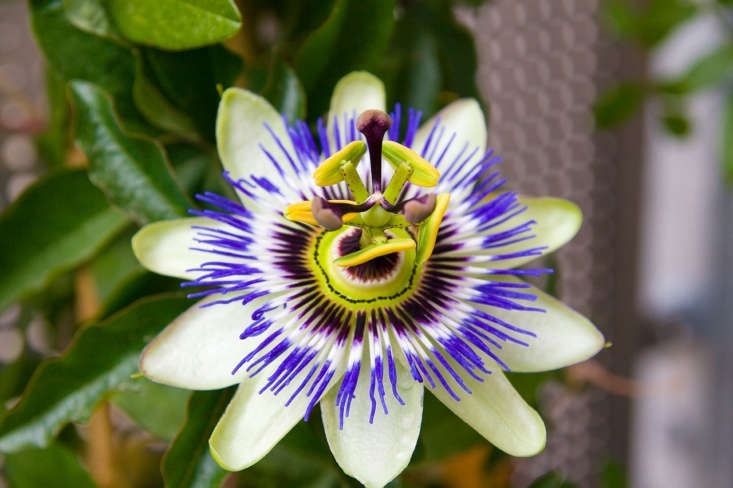Passionflower, Passiflora: Passion Vine
Passion vine can solve many problems in a landscape. Like a strategically placed dab of concealer on the face, vigorous fast growing vines can quickly beautify a garden while mitigating almost any fault. Rusty chain link fence got you down? Tumbledown compost heap turned into an eyesore? Need to make the neighbors’ amateur backyard auto repair shop disappear? Gardeners know the quickest, most politic way to solve those problems is almost always a bushy, rapidly extending vine. Not only will it curtain off the ugliness, it also will replace an eyesore with beauty while expanding the greenery in your garden to new heights.
If you are in the market for a vine, you would do well to consider the amazing Passiflora. It can adorn your landscape with robust foliage and unforgettable blooms that look like miniature ballerinas dressed in frilly, ornate tutus (with crowns of antennas on their tiny heads). Many of its species are fragrant and will produce attractive round or oval fruits with a delicious juicy edible center.
Is passionflower the right choice for your garden? Read on to learn everything you need to know about this fast-growing flowering vine.

My first glimpse of a passionflower came when I was a young teenager in Memphis, walking along the railroad track behind my house. There among the tangle of weeds and discarded junk I caught a glimpse of something round and pale lavender with a spiky fringe around its middle. It didn’t resemble any flower I had ever seen before and I wasn’t sure it was real. It wasn’t until many years later that I finally learned what I had come across.

The plant I saw that day was most certainly Passiflora incarnata or purple passionflower, which is actually a native of the Southeastern United States and is hardy in USDA growing zones 5 to 9. It is commonly called “maypop” because its hollow, yellow fruits will make a loud popping sound when crushed.

Other members of the Passifloraceae family, which contains more than 500 species including some shrubs and even trees, tend to be evergreen tendril-climbing vines originally found in Mexico and South America. Even if you select one of the tropical climbers that is not hardy in your climate, it will probably grow fast enough over the summer to give you good coverage and provide a satisfying flower display. Fruit production, however, can require a long growing season.

Cheat Sheet
- Passion vine is ideal for growing on walls, fences, and trellises.
- In areas where the vine is not hardy, it can be grown outdoors in a container in summer and taken inside to a bright spot out of direct sun during winter (when it should be watered sparingly).
- Avoid having a passionflower vine run rampant over other plants by attaching it to a trellis or wireframe. It can easily grow 20 feet or more a year.
- Prune the vines in the early spring to control growth, promote lush foliage, and increase flower and fruit production.
- The vine’s flowers, which bloom for only one day, do not need to be deadheaded. If they have not been fertilized they will drop of their own accord. If they have been fertilized, (possibly by a bee, wasp, bat, or hummingbird) a fruit will develop at the site of the spent flower.
Keep It Alive
- Most passionflower vines will grow as perennials in USDA zones 6 to 10 (and some varieties will thrive in zone 5 and zone 11, as well) and are happiest and most likely to flower planted in a bright spot with a minimum of four hours of daily sunlight.
- This plant is not fussy about soil but does prefer a well-drained growing medium that is rich in organic matter.
- Keep your plant well watered during the summer to facilitate robust flower and fruit production. The use of an organic mulch will help to keep the roots happily cool and moist.
- Passionflower is delicate, so locate it in a sheltered spot away from wind that can damage tender stems and cause leaf burn.

Within this species there are two forms, purple and yellow. They have somewhat different cultivation requirements and the fruits themselves are different, with the purple considered by many to be less acidic and more flavorful.


The most dramatic forms of passionflower are the bold red varieties. Passiflora coccinea is a tropical plant hardy in USDA zones 10 to 12. Its blooms are a brilliant fire-engine red and as large as three or four inches across.
The passionflower got its name, it is said, in the 16th century when it was discovered in the New World by Catholic Spanish explorers who associated the flowers’ fringed coronas with biblical references to Christ’s crown of thorns and the 10 petals as the 10 loyal apostles (ignoring both Peter and Judas as betrayers of Jesus). It is not known how the indigenous people, who had long used the plant and flower in herbal medicine as a sedative and a pain reliever, might have reacted to the Spaniards’ religious interpretation.
For more growing tips, see Passionflowers: A Field Guide to Planting, Care & Design in our curated guides to Vines & Climbers. Read more about vines.
- 9 Ways to Create Curb Appeal with Flowering Vines and Climbers
- A Vital Vine: 11 Best Varieties of Ivy
- Clematis: A Field Guide to Planting, Care & Design








